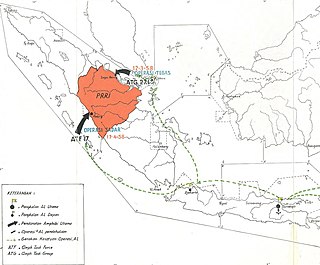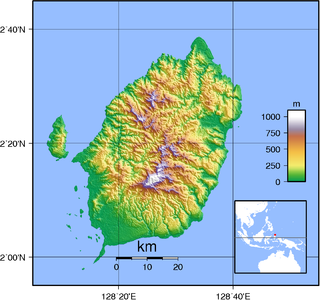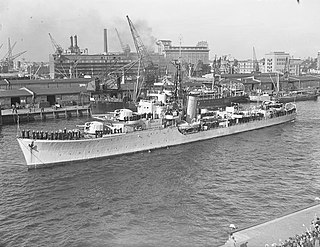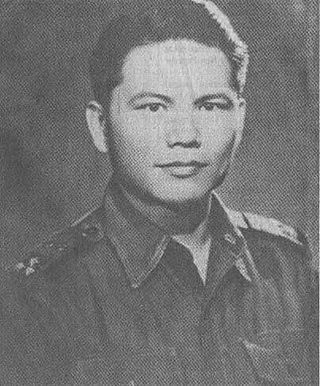
HMS Victorious was the third Illustrious-class aircraft carrier after Illustrious and Formidable. Ordered under the 1936 Naval Programme, she was laid down at the Vickers-Armstrong shipyard at Newcastle upon Tyne in 1937 and launched two years later in 1939. Her commissioning was delayed until 1941 due to the greater need for escort vessels for service in the Battle of the Atlantic.

HMAS Ipswich (J186/B244/A118), named for the city of Ipswich, Queensland, was one of 60 Bathurst-class corvettes built during World War II and one of 20 built on Admiralty order but manned by personnel of and later commissioned into the Royal Australian Navy (RAN).

Ambon is the capital and largest city of the Indonesian province of Maluku. This city is also known as Ambon Manise, which means "beautiful" or "pretty" Ambon. It covers a land area of 298.61 km2, and had a population of 331,254 at the 2010 Census and 347,288 at the 2020 Census. The city is divided into five administrative districts – namely Nusaniwe, Sirimau, Teluk Ambon, Baguala and Leitimur Selatan. Known as Indonesia's music city, Ambon became the first city in Southeast Asia to be recognised as the UNESCO City of Music in 2019.
Civil Air Transport (CAT) was a Nationalist Chinese airline, later owned by the US Central Intelligence Agency (CIA), that supported United States covert operations throughout East and Southeast Asia. During the Cold War, missions consisted in assistance to "Free World" allies according to the Mutual Defense Assistance Act of 1949.

Permesta was a rebel movement in Indonesia, its name based on the Universal Struggle Charter that was declared on 2 March 1957 by civil and military leaders in East Indonesia. Initially the center of the movement was in Makassar, which at that time was the capital of the province of Sulawesi. However, support for the movement in South Sulawesi gradually dissipated, forcing the headquarters to move to Manado in North Sulawesi.

The Revolutionary Government of the Republic of Indonesia was a revolutionary government set up in Sumatra to oppose the central government of Indonesia in 1958.

HMS Aurochs (P426/S26), was an Amphion-class submarine of the Royal Navy, built by Vickers Armstrong and launched 28 July 1945. Her namesake was the aurochs, an extinct Eurasian wild ox ancestral to domestic cattle and often portrayed in cave art and heraldry.

Allen Lawrence Pope is an American retired military and paramilitary aviator. He rose to international attention as the subject of a diplomatic dispute between the United States and Indonesia after the B-26 Invader aircraft he was piloting in a Central Intelligence Agency (CIA) covert operation was shot down over Ambon on May 18, 1958 during the "Indonesian crisis".

Alexander Evert Kawilarang was an Indonesian freedom fighter, military commander, and founder of Kesko TT, what would become the Indonesian special forces unit Kopassus. However, in 1958 he resigned his post as military attaché to the United States to join the separatist Permesta movement where he encountered Kopassus as his opponent. His involvement in Permesta damaged his military career, but he remained popular and active in the armed forces community.
Two ships of the Royal Navy have borne the name HMS Heartsease, after the common name for the wildflower Viola tricolor:

HMS Tetcott was a Type II British Hunt-class destroyer built for the Royal Navy during World War II. She was the only Royal Navy ship to be named after the Tetcott fox hunt.

Hatsutaka was the lead vessel in the Hatsutaka-class of medium-sized minelayers of the Imperial Japanese Navy, which was in service during World War II. She was designed as an improved version of Shirataka anti-submarine netlayer. However, during the Pacific War, due to the critical shortage of escort patrol ships, she was fitted with depth charge racks, her minelaying rails were removed, and she was used primarily for convoy escort duties.

Morotai Island is an island in the Halmahera group of eastern Indonesia's Maluku Islands (Moluccas). It is one of Indonesia's northernmost islands.
William Henry Beale Jr. was a US military and paramilitary aviator. In the Second World War, he was in the USAAF and flew bombing missions in the northern Pacific theater. In the Permesta rebellion in Indonesia in 1958 he flew bombing missions for the CIA. His career ended on a CIA covert mission in Laos in 1962 when he was killed in a plane crash.
SS San Flaviano was a British oil tanker owned by Eagle Oil and Shipping Company, a British subsidiary of Royal Dutch Shell. She was built by Cammell Laird in England in 1956 and attacked and sunk by the CIA in Borneo in 1958.
MV Daronia was a 1930s British oil tanker owned by Anglo-Saxon Petroleum, a British subsidiary of Royal Dutch Shell. She was launched in 1938 by Hawthorn, Leslie in North East England and completed in 1939. She was one of a class of 20 similar tankers built for Anglo-Saxon.
SS Aquila was a cargo ship built in Britain in 1940 for Stavros Livanos' Trent Maritime Co Ltd. by William Gray & Company. An identical sister, SS Duke of Athens, was made for Trent at the same time.
SS Flying Lark was a ship built in Fredrikstad, Norway in 1915 as the banana boat SS Honduras. Over a 43 year career that spanned oceans and seas the world over she had 10 owners, eight names and a succession of different managers.

The destroyer HNLMS Tjerk Hiddes was a British built, Dutch warship of World War II. She was laid down on 22 May 1940 as a British N-class destroyer and launched on 25 June 1941 as HMS Nonpareil, but on 27 May 1942, she was transferred to the Royal Dutch Navy. The ship was commissioned in 1942 as HNLMS Tjerk Hiddes, named after the 17th century Dutch admiral, Tjerk Hiddes de Vries. Much of her war service was with the Royal Navy and United States Navy in the Indian Ocean and Australia. Following the war, the destroyer was sold to Indonesia and renamed KRI Gadjah Mada. She was scrapped in 1961.

Jacob Frederick Warouw, also known as Joop Warouw, was a military officer involved in the Indonesian National Revolution. After the revolution, his appointments include Commander of VII/East Indonesia Military Territory and Military Attaché in Beijing. He was subsequently involved in the Permesta movement that sought greater regional autonomy from the central government in Java. He was killed by a fractious unit toward the end of the movement.












